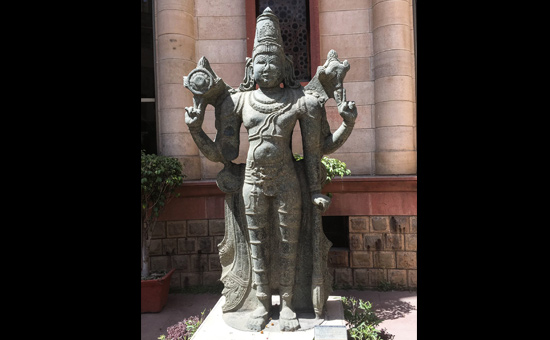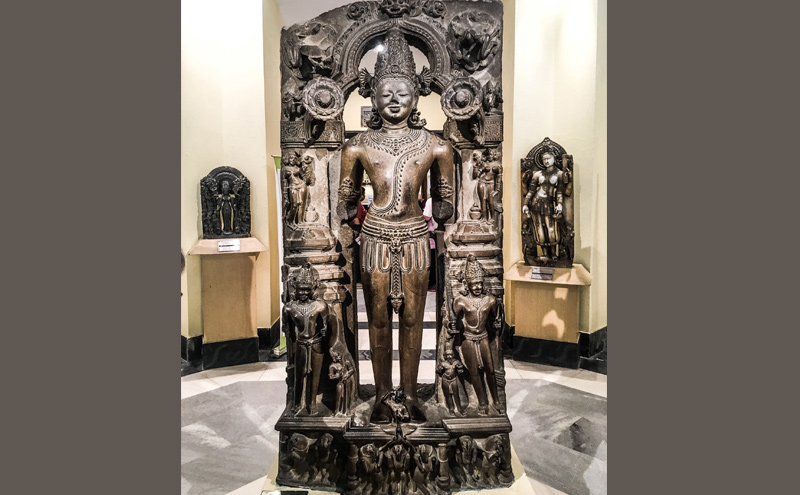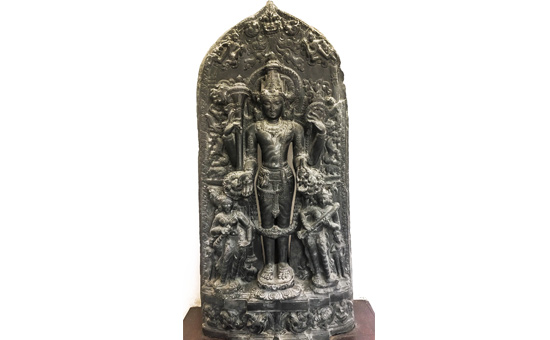- Article tells about the various weapons found in sculptures of Hindu Gods and Goddesses and their significance.
When we see a murti and try to
identify it, often the first thing we do is to check the accessories in his or
her hands. These include weapons, musical instruments, birds, animals, etc.
These ayudhas, besides helping to differentiate and identify the
different deities, are primarily used to symbolise the diverse activities of
the gods and goddesses.
As T.A.G. Rao explained, “the
images of Hindu gods and goddesses are representations of the various conceptions
of divine attributes. Sculpturally it may be said, the number of hands in an
image represents the number of attributes belonging the deity, and their nature
is denoted by the ayudha held in the hand or by the pose maintained by it”
(Vol I, part I. Introduction, p.27).
These accessories, in many instances,
have also turned into emblems of the different sects within Hinduism. Since the
images are generally seen in anthropomorphic forms, the accessories shown
on them are similar to what were used and worn by the people of those times,
thus giving us a fair idea of the dresses and ornaments worn, and weapons and
musical instruments in vogue at that time.

The sculpturing of these accessories
vary from region to region, and also from dynasty to dynasty (in reference to
works created under different dynasties, such as the Chola bronze murtis are
different from the Vijaynagara ones). Thus, we find that early Chalukya,
Pallava, and early Chola works cover more or less the same region, yet are
varying in sculptural intricacies. Their simple yet more realistic
representations are no less beautiful than the later artistically more
elaborate sculptures of the later Chalukyas and Hoysalas.
Similarly, while ruling over the same
region in Eastern India, the Gupta, Pala and Sena dynasties show differences in
their design and styling of accessories. Additionally, the eastern Indian
sculptures can be easily differentiated from their north and south Indian
counterparts, owing to typical regional influences seen in the
sculptures.
The north Indian Surya and south
Indian Surya can be immediately differentiated from a study of their
accessories. The north Indian Surya is seen in his udicyavesa (that
include the tightly netted vest like covering on his torso, and his boots) and
the waist girdle or avyanga; while the south Surya lacks both.
 North
Indian styled Surya.
North
Indian styled Surya.
Caption – North Indian styled wearing udicyavesa
(the thin net like vest on his torso and boots), Konark, National museum Delhi.
 Vishnu with his signature weapons: Sankha, Chakra, and
Gada; Pala dynasty.
Vishnu with his signature weapons: Sankha, Chakra, and
Gada; Pala dynasty.
 Durga with her weapons while resting on her lion,
Pallava dynasty.
Durga with her weapons while resting on her lion,
Pallava dynasty.
Examining the weapons specifically, it is seen that
there are some that are more commonly seen in the hands of the deities. These
are:
Chakra: seen in the hands of Vishnu it is considered as a
Vaishanava symbol. It is also seen in the hands of Durga, and closely resembles
a quoit with sharp edges, which could be thrown at the enemy for cutting him
through. It is generally held side way by the rim, and looks like a wheel
with spokes.
In a more ornamented form the spokes are styled like
lotus petals and the internal circular part appears like a full blown lotus.
Sometimes there are ornamentation around the rim, and a ribbon like jewelled
piece is seen around the chakra, which is also used for holding it while
keeping it front facing. (Photo I, figs 4 and 5)
Sankha: sankha or a conch shell, was blown during wars in
ancient times for inspiring the soldiers and creating a feeling of terror among
the enemies.
In Bhagavad Gita, we find the
mention of pancajanya sankha used by Krishna
(Vasudeva-Vishnu), which was made from the bone of an asura named Pancajana.
(Photo I, figs 1 and 2).
Gada: a club or a mace. It is thicker than a cudgel/danda,
though sometimes it is difficult to differentiate between the two, especially
in the early coins and seals. With a thick top and tapering end, a gada
is held firmly with all fingers, and is meant for hitting at the enemy from a
close a range, hence should never leave the hand. Iconographically it can be
shown plain or with ornamentation. The gada seen in the hands of Vishnu is
known as kaumodaki, or kaumodi (Photo 1, figs
6, 7, 8).
Khetaka: a shield that is either circular or quadrangular or
oblong in shape. It is a defensive weapon and held by a handle at its back. It
may be made of metal, or wood, or leather (hence it is often referred to
as carma/charma in different texts) (Photo 1, figs 11
&12).
Khadga: is a sword, and the swords seen in the hands of
different deities often have different names, such as nandaka (Vishnu), nistrimsa (consort
of Pradyumna), etc. (Photo 1, figs 9 &10).
 Photo 1
Photo 1
Musal: wooden pestle. An offensive weapon made of
cylindrical hard wooden rod that can be used to hit the enemy. The weapon is
mostly seen in the hands of Balaram (Photo 2, fig 1).
Hala: A plough, which was likely used also as a weapon
during the wars. Seen carried by Balram (Photo 2, fig 1).
Dhanush and Sara: refers to a bow and arrow (also known as bana).
Dhanush or a bow has three different shapes as seen in the photo 2 (figs 2, 3,
and 4). fig 2 has the shape of an arc, while fig 3 has three bends, and the one
in fig 4 has five bends. These three images of the bows also show the gradual
evolution of the dhanush or bow from a primitive and simple weapon to a more
complex one in the later periods.
The bows also have different names based
on the gods that carry them. As for
example, Shiva carries the bow name as Pinak, and Vishnu carries the bow known
as Sarnga. Manmatha (Kamdev, Pradyumna, who is Mara in Buddhism) carries five
arrows (pancasara) and a bow known as pushpadhanush, as it is floral in nature.
In medieval era often Manmatha is seen carrying a sugarcane bow. (Photo 2, fig
2, 3, 4, and 5).
Tanka: a stone mason’s chisel though a tool, is often shown
in the arms of a deity as a weapon, as it may have been used for offensive
purposes during wars in the ancient times. (Photo 2, fig 11).
Parasu: A battle-axe, with a steel blade and wooden handle.
The blade is either fitted into a hole on the wooden handle or is attached to a
ring on the handle. The older version of battle axes is seen in
Photo 2, fig 6. The later period axes look more like a steel blade fitted into
a short wooden block similar to that of a gada, and appears disproportionate
(Photo 2, fig 7).
Khatavanga: a club that was initially conceived as made of bone
from a forearm or a leg and has skull on top fitted through the foramen (hole
in a bone). Later the design was altered to show a long ornamented wooden
handle with a skull on top. It seen in the hands of fierce form of the deities,
such as Bhairav and Chamunda (Photo 2, figs 9 and 10).
Agni: agni
or fire is seen both as an offering or a weapon. As a weapon it is
shown as a fire ball that we see in the hands of Shiva-Nataraja, or as torch
that can act as an incendiary weapon (Photo 2, figs 12 and 13).
As an offering it is shown as flames issuing from a
sacrificial pot, as for example, in Kalyanasundaramurti of Shiva (Photo 2, fig
14).
 Photo 2
Photo 2
Sula:
the famous weapon seen in the hands of Shiva. The long handle is wooden that
ends in a metal tri-pronged pike (Photo 3, figs 1 and 2). In early
representations of Shiva in seals and coins often the god was seen carrying a
weapon that combined the sula and parasu (battle-axe)
together.
Sakti: It is a spear (a sharp pointed metal with a long
wooden handle), and seen in the hands of Durga and Kartikeya (Photo 4, figs 8
and 9).
Ankusha: An elephant goad. Used in wars as weapon as it
has a sharp hook made of metal attached to a short or long wooden stick (Photo
4, figs 3 and 4).
Vajra: thunderbolt seen in hands of Indra and Shiva. It is
depicted in two ways. One is a simple representation like a club that is narrow
in the middle and wide at two ends. The other is more elaborate with
ornamentation, and is a double faced weapon with sharp three claws at two ends
which is held by the narrow middle part (Photo 3, fig 7).
Pasa: A noose made of ropes, which is used for tying
enemies. It is shown as loops in the hands of deities, varying from single to
multiple loops (Photo 3, figs 5 and 6)
 Photo 3
Photo 3
 Photo 4
Photo 4
References
1. Ananda
K. Coomaraswamy. Early Indian iconography.
2. Jitendranath
Banerjea, The Development of Hindu Iconography.
3. Kramrisch,
S, Indian Sculpture.
4. T.N.
Gopinath Rao, Elements of Hindu Iconography.
To read all
articles by author
Author studies life sciences, geography, art and international relationships. She loves exploring and documenting Indic Heritage. Being a student of history she likes to study the iconography behind various temple sculptures. She is a well-known columnist - history and travel writer. Or read here
Article
was first published on author’s blog and here
Article and pictures are courtesy and copyright author.